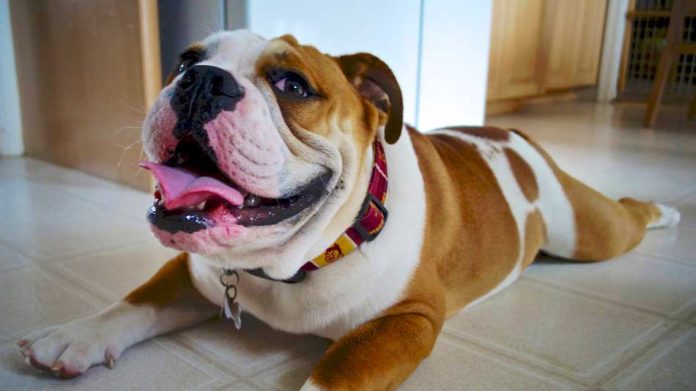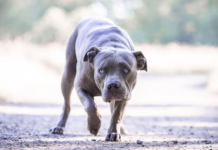Last Updated on January 20, 2024 by Fumipets
The Victorian Bulldog: Unveiling the Gentleman of Bulldogs
In the realm of bulldog breeds, one stands out as a true gentleman—introducing the Victorian Bulldog. This breed embodies the charm and elegance of the Victorian era while possessing the strength and tenacity of a classic bulldog.
With a history deeply rooted in England’s past, the Victorian Bulldog has emerged as a beloved companion, known for its affectionate nature and distinctive appearance. Join us on a journey to discover the unique traits, history, and the captivating world of the Victorian Bulldog.
The Victorian Bulldog
You can’t get enough of the Victorian Bulldog? Of course, this puppy’s cute face and strong frame are some of the characteristics that make it popular among dog enthusiasts.
This dog, sometimes known as the Olde Victorian Bulldog, is a reproduction of an extinct breed. In 1985, breeder Kenn Mollet launched a campaign to revive this breed that had vanished with the passage of time.
In the Edwardian era, he reproduced a dog that was considered to have vanished from existence. To create a Bulldog that was healthier than other Bulldogs, he meticulously crossed English Bulldog, Bull Mastiff, Bull Terrier, and Staffordshire Bull Terrier.
A bigger, healthier, more active, and more muscular form of an English Bulldog is now available to dog lovers thanks to this breed. It is a wonderful family dog that is kind, active, and wonderful for both elderly and younger households.
Don’t be misled by the serious, grumpy look. Victorian Bulldogs were bred to provide loads of sloppy licks, despite the fact that they were intended to impose a furious look. It also requires little upkeep!
The Victorian Bulldog is more than just that. You might want to keep reading.
| Height: | 16 – 19 inches |
| Weight: | 55 – 75 pounds |
| Lifespan: | 12 – 14 years |
| Colors: | White, red, fawn, pied, brindle |
| Suitable for: | A family with children, singles, a home with a yard |
| Temperament: | Loving & Loyal, kind, happy, easy to train |
What’s the Price of Victorian Bulldog Puppies?
Make sure the breeder from whom you get your Victorian Bulldog puppy is a seasoned, respected, and well-established one. This is due to some breeders mislabeling second- and third-generation bulldogs as Victorian Bulldogs since they are unable to tell them apart.
In order to reduce the likelihood that you may have future hereditary health problems, a professional breeder will also have the medical histories of your possible dog’s parent breeds.
Due to their scarcity, Victorian Bulldog puppies cost between $1,500 and $3,000 each. However, depending on the breeder, this exorbitant price tag may rise to $5,000.

3 Little-Known Facts About Victorian Bulldog
1. They Represent “Resurrection Breeding” at its Finest.
The Victorian Bulldog was developed via selective breeding to mimic the early 19th-century Bulldog breed’s look. Sadly, this makes them resemble the Bulldogs of a century ago rather than the ones of today.
2. Victorian Bulldogs Have Interesting Legs
Your dog’s hindquarters may seem to be a little higher and lighter than those of an English Bulldog. This physique does not, however, undermine the well designed symmetry of the breed.
3. They Are Rare
Unfortunately, there aren’t many lineages for Victorian Bulldogs. Because of this, it may be difficult to obtain authentic Victorian Bulldogs, despite the fact that they are quite desirable.
They only made their way back to the world in the past decade.
Temperament & Intelligence of Victorian Bulldog
The Victorian Bulldog is a vivacious, happy, and well-balanced canine. It never turns down an opportunity for adventure or couch-cuddling.
These dogs do really seem austere and pessimistic. However, they are loving, kind, and somewhat kind. They make great playmates because of their lively personalities, sturdy physiques, and tolerance toward children.
Victorian Bulldogs adore affection and would appreciate it if you showed it to them. They would not like being left alone for an extended period of time and would need a lot of love, care, and attention. See how much they like being cuddled and having their bellies scratched!
Another benefit of Victorian Bulldogs is that they don’t often bark, so unless anything irritates them, you shouldn’t anticipate much noise. But once they start barking, it’s hard to get them to stop.
Other than occasional snores and slobbery kisses, they aren’t really noisy.
Are These Dogs Good for Families? 👪
These dogs are fantastic with small children, so they’ll fit right into your family and flourish in a family environment.
Just because you live in an apartment doesn’t mean you have to give up on this dog. Due to their very laid-back personalities, Victorian Bulldogs don’t need a large yard to play and run about in.
People’s dogs is a term that accurately describes these canines. They are devoted, dependable sweethearts who like company and human interaction. If your dog spends the whole day cuddling up to you on a sofa, it will be at its best.
Victorian Bulldogs also possess bravery and protective instincts, ensuring the safety of you and your family at all times.
This dog enjoys having kids clamber all over it since it is tolerant and genuinely kind toward them. You must educate your children about limits since they still have a breaking point.
Slobbery, snoring, and drooling are characteristics of the Victorian Bulldog. They are, nonetheless, devoted and kind friends that like spending time with you.

Does This Breed Get Along with Other Pets?
These canines are perfect family dogs since they accept other dogs and perform well in multi-pet families. If they were well socialized or grew up together since they were puppies, you in particular won’t notice any issues.
But if you don’t reinforce good leadership training, some dogs might have strong hunting drives and be fearful of other dogs.
Things to Know When Owning a Victorian Bulldog
You will without a doubt fall in love with this puppy the moment you see it. There are several aspects about it, however, that you should be aware of before bringing it home. Consider this:
Diet & Food
Victorian Bulldog owners must demand that their dogs only eat raw food, much like owners of other Bull breeds. Try to avoid feeding it a diet that is exclusively composed of meat however, since the bones, intestines, and stomach are too similar to its prehistoric eating habits.
It’s essential to keep in mind that excessive protein in the diet might lead to hot patches in bull breeds, who cannot handle it. To balance your dog’s diet, you may give him raw eggs, yogurt, semi-cooked vegetables, and fruits.
However, if you want to give your Bulldog a raw food, you need to have a fundamental knowledge of nutrition. Therefore, it would be wise to get advice from a veterinarian if you are a new owner.
You might also just stick to wholesome commercial dry dog food. Divide 34 to 112 cups of dry dog food into two portions each day. Dry dog food aids in plaque removal, which is good for your dog’s oral health.
Exercise 🐕
Victorian Bulldogs are non-working canines with average levels of activity. When inside, they love to relax on the sofa. If you want them to be happy, healthy, and successful, you must still provide them with regular exercise every day.
This dog can adjust to living in an apartment. However, since it is more athletic than its English Bulldog ancestors, it will flourish better in a household with a yard that is big enough to enable it to run about.
Additionally, you need to provide it off-leash time in a secure park a few times per week along with daily mild walks.
But don’t overdo it with the exercise. Due to their narrow snouts, these breeds often get overheated. When it’s time to stop, you should be on the lookout for overheating or overexertion symptoms.
Training 🎾
Victorian Bulldogs are clever dogs who have a kind disposition that makes them amenable to training.
Unfortunately, most owners teach them dominance since they are Bull breeds, which is completely the reverse of what should be done. Any dominance- or force-based training does not work on these dogs.
Instead, Victorian Bulldogs respond well to rewarding training methods, particularly when a clicker is used. When teaching your dog the fundamental instructions, clicker training may be useful and entertaining at the same time.
But sometimes they may be a bit obstinate. To assist make the training considerably more motivating, you may employ food-based incentives. Given their intellect, dogs will profit from toys, puzzle games, and boredom-busting blockbusters.
Grooming ✂️
Since it sheds on average, this breed is often low care and just requires little brushing. Victorian Bulldogs have short, silky hair that only has to be brushed once a week, or more often if you like.
Bulldog breeds are renowned for having wrinkled cheeks that need be cleaned often to prevent infection and skin discomfort. You must wash your dog many times a week because of this.
If you want to help keep your dog happy and free of skin issues, gently wipe the creases with a moist cloth each day.
In addition to the coat, make sure you give your dog regular grooming, such as nail clipping. If your dog isn’t wearing them down as much, you may cut the nails more frequently—once a month, for example.
Floppy ears on the Bulldog enhance its charm. It is crucial to constantly examine their ears while grooming them since such ears hold moisture, dirt, and debris, which leads to ear infections.
Additionally, use enzyme toothpaste every day to wash their teeth and gums to avoid dental disease. By doing so, tartar accumulation that leads to tooth decay and gum disease is reduced.
Health & Conditions 🏥
Being developed to be healthier than the English Bulldog lineage, the Victorian Bulldog is a breed that is generally in good condition. Its original breeder insisted on avoiding many of the hereditary problems that Bulldogs often have.
There are several medical issues, nevertheless, that you should either anticipate or at the very least be aware of. They consist of:
Cherry Eye – As they age, Bulldogs are more prone to visual issues such as the Cherry Eye, which often manifests as a red lump at the corner of the eye. It is brought on by an enlarged third eyelid gland that is prolapsing as a consequence.
Skin Issues – These dogs are prone to skin infections, rashes, puffiness, and hot spots brought on by insect bites and other skin irritants. Using medicated shampoo and bathing your skin often is the greatest approach to avoid skin problems.
With the advice of your family veterinarian, consider vitamins as well.
Obesity – These dogs are vulnerable to obesity because they are overfed or don’t get enough exercise. They also develop elbow and hip dysplasia, as well as respiratory problems, as a result of it.
Hip and Elbow Dysplasia – Because of their sturdy physique, these dogs are more likely to have joint and bone issues than English Bulldogs. This disease is also exacerbated by obesity.
When bones of the elbow and hip don’t fit tightly into their joints, this condition is called dysplasia. It results in discomfort, lameness, and an intolerance to activity.
Heat exhaustion – Victorian Bulldogs, like English Bulldogs, have brachycephalic faces. It is another term for a face that is squished together, with a nose that is pushed in, a short snout, and little breathing holes.
Due to this, even while panting helps control its body heat, it has difficulty doing so when exercising. Because of this, you should make sure your house has an air conditioner, limit how much they exercise, and stay indoors during the summer.
Allergies – Due to its genetic makeup, this dog is more likely to have dietary sensitivities including gas and skin allergies.

Minor Conditions
• Cherry Eyes
• Obesity
Serious Conditions
• Hip & Elbow Dysplasia
• Cancer
• Difficulty Breathing
• Allergies
Male vs. Female
Typically, female Victorian Bulldogs are a little bit smaller than males. They only weigh 55 to 65 pounds compared to the guys’ 65 to 75 pounds. Additionally, female Victorian Bulldogs are shorter than men.
In contrast to the females, the males are often more lively and energetic.
Conclusion
If you desire a dog with English heritage, you can buy a Victorian Bulldog. This dog is extremely cute, requires little upkeep, and is a wonderful family companion.
Q&A: The Victorian Bulldog
What distinguishes the Victorian Bulldog from other bulldog breeds?
The Victorian Bulldog is recognized for its distinct appearance, characterized by a moderately loose, wrinkled skin, a pushed-in nose, and a muscular, yet agile body. Unlike some other bulldog breeds, Victorian Bulldogs have a longer, more refined muzzle and a less pronounced underbite.
What is the history behind the Victorian Bulldog’s name and lineage?
The Victorian Bulldog gets its name from the Victorian era (1837-1901) in England when bulldogs gained popularity. This breed is a recreation of the original bulldog of that era, emphasizing traits that were cherished during Victorian times, such as gentleness and loyalty.
Are Victorian Bulldogs known for their temperament and suitability as family pets?
Yes, Victorian Bulldogs are renowned for their gentle and affectionate nature. They are excellent family pets, known for their loyalty and compatibility with children and other animals. They thrive on human companionship and make loving, devoted family members.
What are the exercise and grooming requirements for Victorian Bulldogs?
Victorian Bulldogs have moderate exercise needs and are not overly active. A daily walk and some playtime suffice to keep them healthy and content. Grooming involves brushing their short coat occasionally and cleaning the facial wrinkles to prevent skin issues.
Are there any health considerations specific to the Victorian Bulldog breed?
Like many bulldog breeds, Victorian Bulldogs may be prone to certain health issues, including hip dysplasia and respiratory problems due to their flat faces. Responsible breeding practices aim to minimize these concerns, but potential owners should be aware of these breed-specific health considerations and provide appropriate care.


















